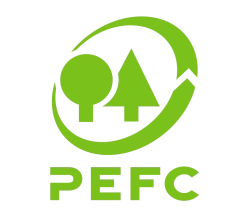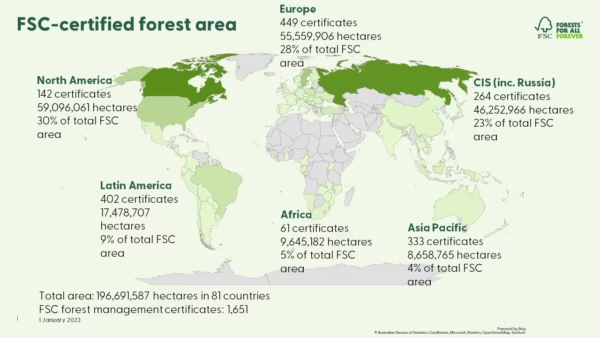How Illegal Logging Is Tackled Worldwide
Everyone is familiar with the problem of illegal logging. Wood is valuable, and not every country manages to protect it from theft. As a result, these precious natural resources continue to dwindle, bringing with them all the associated negative consequences.
In this article, we’ll explain the initiatives in place to protect our precious forests. We’ll take a closer look at the roles of CITES, PEFC, FSC, and FLEGT. Too few people know what these abbreviations stand for and what they actually do. So let’s explore them in more detail.

Deforestation by the Numbers
Here are a few facts to illustrate the scale of the problem:
- The Earth has lost one third of its forests since the invention of agriculture.
- Even today, 80% of deforested areas are converted into agricultural land.
- Global deforestation peaked in 1980. After that the pace slowed down, but it didn’t stop.
- Between 2000 and 2020, the total forest area on Earth decreased by 2.4%.
- According to WWF estimates, 15-30% of forests are illegally logged worldwide every year.
- In tropical forests, 50 to 90% of logging is illegal.

You might wonder whether it's ethical to have wooden products in your home.
Is wood actually sustainable?
Convention of International Trade in Endangered Species of Wild Flora and Fauna (CITES)
CITES is an international agreement that aims to combat the trade in endangered animals and plants. Since its establishment in 1973, CITES has become one of the key tools in the fight against the trade in endangered species. Today, nearly all countries in the world are members. This significantly reduces the appeal of illegally logging endangered trees.

CITES classifies endangered species into the following three groups:
- Appendix 1: Species threatened with extinction. The trade of these species is prohibited.
- Appendix 2: Currently not endangered, but at risk. Trade in these species is restricted.
- Appendix 3: Species that are protected in only one or a few countries. Demonstrating that the species does not come from the respective country is often sufficient.
In fact, CITES blocks the import and export of endangered species. However, in exceptional cases, a permit can be obtained to transport endangered species across borders. For the other groups, measures such as quotas or certificates of origin apply. Customs authorities enforce these regulations.
Illegal Logging and Certification
Perhaps the most well-known measure is the certification for wood and paper. Such a certification tracks the supply chain from the forest to the end customer. The key aspect here is whether the forest is being properly managed. For this so-called sustainable forest management, the organization issues a certificate.
The cornerstones of sustainable forest management:
- Conservation and, where possible, the enhancement of biodiversity.
- Harvesting materials and substances in alignment with the forest's capacity for regeneration.
- Respecting the interests of local communities.
In short, a forest manager can become certified for a fee. This allows the forest manager to demonstrate adherence to the principles above, including combating illegal logging. As a result, their wood becomes more valuable. The two most well-known certifications are PEFC and FSC, whose labels can be found on wood products.


Forest Stewardship Council (FSC)
FSC was founded in 1993 and sets a global standard for sustainable forest management. Wood products sourced from forests managed according to their standards bear the FSC certification. Products with FSC certification guarantee that they cause minimal harm to both nature and people.
The FSC sets the highest standards for its certification. For this reason, organizations such as WWF praise the FSC, but these high standards come with a price tag. Due to the cost of certification and annual inspections, it is primarily forests in developed countries that carry the label. 75% of FSC-certified forests are located in Europe, North America, and Russia, which are not the regions where the most issues with illegal logging occur.

Programme for the Endorsement of Forest Certification (PEFC)
PEFC was established in 1999 and is one of the largest certifications in the world. Unlike FSC, local parties have more input, as long as they meet the PEFC standards. Additionally, multiple small forests can group together to apply for an audit and share the costs. This makes participation possible for smaller forest managers in less developed countries. However, this certification is generally considered less strict.
Forest Law Enforcement, Governance and Trade (FLEGT)
Another important step in the fight against illegal logging is the FLEGT Action Plan. It was launched in 2003 by the EU, and it is used to collaborate with timber-producing countries. A participating country must set up a reliable control system. Afterward, they can issue a FLEGT license for their timber shipments, which allows them to undergo less stringent customs checks.
Since 2016, Indonesia has been the only country allowed to issue FLEGT licenses for their timber. For a long time they were the only member, but Ghana will join them by mid-2025. Additionally, a few other countries are candidates for participation but have not yet met the requirements. However, the fact that only one country is currently allowed does not mean that the action plan is not working well.
The effect of the FLEGT Action Plan in Indonesia:
- In 2008 80% of logging in Indonesia was illegal.
- In 2012 Indonesia logged the most timber in the world.
- In late 2016 Indonesia was admitted to FLEGT, after which deforestation began to decrease.
- By 2021, illegal logging had decreased by 64%.

Conclusion
The initiatives we have discussed are all vital for the protection of our forests. Here’s a recap of the different ways they achieve this:
- CITES protects endangered species.
- PEFC and FSC ensure sustainable forest management.
- FLEGT focuses on stopping illegal logging.
Unfortunately, this issue hasn’t been fully resolved yet, but the world continues to work on it. During the COP26 summit, 100 countries agreed that 2030 should be the year when global forest area starts to grow again. As consumers, we can also contribute to this goal. Although, not simply by switching to other materials. Instead, support companies that consciously address this issue and are working towards a better future.
